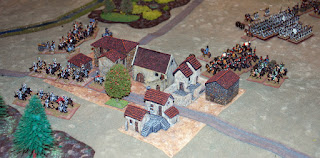For the first game of the new year, Phil hosted us at his house for an introduction to the
Field of Glory - Napoleonic (FoG-N) rules. The game pitted two small French corps with cavalry against two British divisions with cavalry. Roger and I (Col Campbell) played the British against Phil and Ed as the French.
As the British commander, my comments are from their perspective.
 |
| Looking from behind the French right hand corps at the British defenses. A KGL light brigade defends the small town in the center of the picture. |
Each French corps had two divisions, each of three regiments, plus artillery. For cavalry, the French had a dragoon division with three brigades and a light division with two hussar and one chasseur brigades. Marshal Massena was the overall commander.
 |
| The British right flank is in the foreground with the French left hand division and dragoons deployed in the background. |
The British had Picton's division with three British and one Portuguese brigades, plus artillery, and the 7th Division with one British light brigade, one KGL light brigade, and one Portuguese brigade, plus artillery. The British cavalry consisted of two British/KGL dragoon brigades, one British light brigade, and one KGL light brigade. There were also some Spanish - one infantry brigade, one light cavalry brigade, plus artillery. Wellington was in overall command.
 |
| The far British right flank was composed entirely of cavalry with the two dragoon brigades on the left and the two light brigades on the right. The three French dragoon brigades were beyond the town. The French left hand corps can be seen stretched out in the left background. |
|
|
 |
| The main French battle line with one corps in the right foreground and the other in the left background with the French light cavalry division on the horizon. |
|
|
 |
| The center of the British line with Picton pointing with his trademark umbrella and Wellington right beyond him. The French have advanced to the foot of the slope against Picton's Portuguese brigade and the Spanish brigade, but that was as far as they ever got! |
 |
| On the British right I advanced the two dragoon brigades up to the corner of the town and then the French dragoons advanced closer to me - just what I wanted them to do! In the background my two light cavalry brigades also advanced while a French dragoon brigade rode around behind the town to guard against being outflanked by them. |
 |
| Over on the British left, Roger maneuvered the 7th Division's Portuguese brigade into a newly planted crop field to the left of the town. The French division opposite him deployed all three regiments on line with a leger regiment opposite the Portuguese. In the left background, the French light cavalry began an outflanking movement. It would come to nought. |
 |
| Picton's combined divisional artillery fires at medium range against a French regiment with six dice, getting five hits which results in the French wavering (two yellow rings). They were really never able to recover from this pasting. The British brigade on the right has been disordered from French artillery fire. |
 |
| After the cavalry melee initiated by the British and KGL dragoons, the French dragoons are broken and flee the victorious British. They could not be rallied and rode from the field. |
 |
| To the right of the town, my impetuous British light cavalry brigade charged the French dragoons but came up on the short end and were forced back. However the French didn't pursue very far and left themselves vulnerable to the KGL light brigade. |
 |
| Back on the British left, the 7th Division's British light brigade has moved up to the left of the Portuguese and the Spanish light cavalry brigade has moved over behind them. Meanwhile the French light cavalry move slowly closer. |
 |
| A look down the opposing battle lines with the French right/British left in the foreground. The French infantry never really got much closer to the British line than they are now. |
 |
| The veteran KGL light brigade (being "played" by British light dragoons) charge the French dragoon brigade. |
 |
| And send them fleeing for their very lives! In five cavalry melees on this flank, the British won four of them. I have never done better as a cavalry commander than I did in this battle! |
 |
| A final look at the exposed French left flank with many of their regiments in square. The British cavalry has an unopposed route into the French rear. Massena decides that his day is done and begins a slow withdrawal. Since the French are in square and the British cavalry is spent after all of the fighting they did, Wellington reluctantly lets the French fall back. |
The objectives of the fight were the "exits" off the board for each side. The French couldn't penetrate the resolute British-Portuguese-Spanish defense while the British cavalry had completely defeated their French opponents and had an open route to the French "exit." We called the game at that time.
Ed also took a batch of photos. I'll let him post them as a report from the French perspective.






















